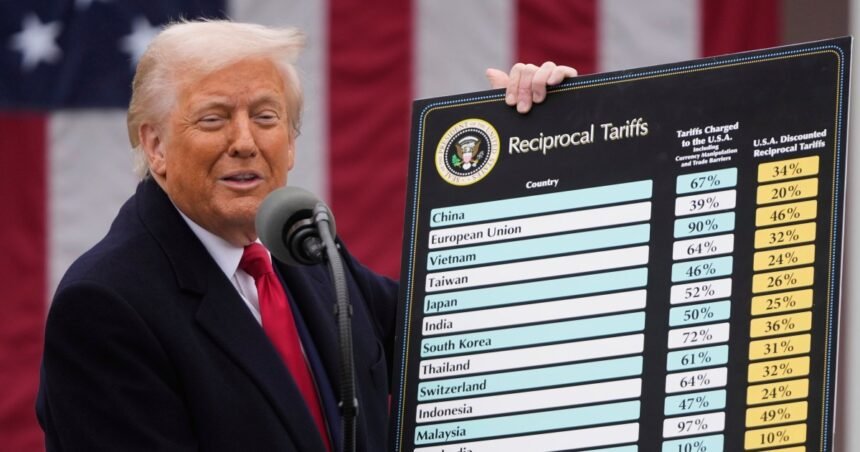When United States President Donald Trump unveiled his steep “reciprocal” tariffs on dozens of nations in April, economists issued warnings of catastrophic financial hurt.
To this point, their fears haven’t materialised.
The US economic system – the one greatest driver of world development – has defied expectations throughout quite a few metrics, with inflation staying low, employment and client spending remaining strong, and the inventory market reaching report highs.
Nonetheless, even when the restricted fallout from Trump’s tariffs has taken some analysts without warning, economists warn that the US and world economies may be experiencing the calm earlier than the storm.
Dozens of US commerce companions, together with shut allies similar to South Korea and Japan, are going through tariffs of 25 p.c to 40 p.c except they seal commerce offers with the Trump administration by an August 1 deadline.
“Once you begin to see tariffs at 20 or extra, you attain a degree the place corporations could cease importing altogether,” Joseph Foudy, an economics professor on the New York College Stern Faculty of Enterprise, advised Al Jazeera.
“Corporations merely postpone main choices, delay hiring, and financial exercise declines,” Foudy added.
“The uncertainty round commerce in that sense is as expensive because the precise tariff charges.”
Even international locations which can be capable of hammer out a deal in time are more likely to face considerably greater duties.
Trump’s preliminary agreements with Vietnam and China, introduced in Could and early July, respectively, stipulate minimal tariff charges of 20 p.c and 30 p.c.
On Friday, the Monetary Instances reported that Trump was pushing for a tariff of 15-20 p.c on the European Union, which is the US’s single largest buying and selling accomplice and is going through a 30 p.c obligation from August 1, in any deal reached with the bloc.
Ursula von der Leyen, the president of the European Fee, has warned that Trump’s mooted 30 p.c tariff would “disrupt important transatlantic provide chains, to the detriment of companies, shoppers and sufferers on either side of the Atlantic”.

‘Hurt development’
“In my opinion, the few tariff agreements which have been reached symbolize nontrivial adjustments in US commerce coverage and so will hurt development, so even when a lot much less excessive than threatened, will matter,” Steven Durlauf, a professor of economics on the College of Chicago, advised Al Jazeera.
Economists broadly agree that the impression of tariffs carried out to this point has not been absolutely felt, as many companies constructed up their stockpiles of inventories upfront to mitigate rising prices.
Below the present measures – together with a baseline 10 p.c obligation on practically all international locations, and better levies on vehicles and metal – the efficient common US tariff fee at present stands at 16.6 p.c, with the speed set to rise 20.6 p.c from August 1, in response to The Funds Lab at Yale Division of Economics.
Even when Trump doesn’t sharply hike tariffs on August 1, economists anticipate inflation to rise at the least considerably within the coming months, with greater costs in flip more likely to drag on development.
In an evaluation revealed final month, BBVA Analysis estimated that even the present stage of US tariffs may scale back world gross home product (GDP) by 0.5 of a share level within the quick time period, and by greater than 2 share factors over the medium time period.
“It’s too quickly to anticipate massive results on costs within the US, as there was a big enhance in exports to the US in anticipation of upper tariffs, and corporations are ready to see the place issues will find yourself by way of tariffs that have an effect on them. So, not shocking, we now have seen restricted results to this point,” Bernard Hoekman, director of International Economics on the Robert Schuman Centre for Superior Research on the European College Institute in Florence, Italy, advised Al Jazeera.
“But when the US does what it has indicated it desires to do – increase common tariffs to the 20-30 p.c stage – there will likely be a a lot bigger impression.”
Trump and his allies have repeatedly dismissed economists’ warnings about his tariffs, pointing to the regular stream of optimistic knowledge to make the case that the financial consensus is flawed.
“The Pretend Information and the so-called ‘Specialists’ have been flawed once more,” Trump wrote on Reality Social in response to a current report from his Council of Financial Advisers (CEA) that discovered costs of imported items fell by 0.1 p.c from December to Could.
“Tariffs are making our Nation ‘BOOM.’”

The CEA report’s methodology drew criticism from some financial analysts, with the Nationwide Taxpayers Union saying it didn’t take account of stockpiling by importers and lined a interval that was “means too quick to attract any definitive conclusions”.
Regardless of the sturdy headline figures on the US economic system, economists have additionally pointed to warning indicators within the knowledge.
In a observe final week, Wells Fargo economists Tim Quinlan and Shannon Grein identified that discretionary spending on providers within the US fell 0.3 p.c within the 12 months as much as Could, indicating potential financial storm clouds forward.
“That’s admittedly a modest decline, however what makes it scary is that in 60+ years, this measure has solely declined both throughout or instantly after recessions,” Quinlan and Grein mentioned.
Durlauf, the College of Chicago professor, mentioned the Trump administration had little trigger to see the relative well being of the economic system up till now as a vindication of its financial plans.
“First, there’s widespread perception that tariff threats is not going to be realised in precise agreements. Second, the consequences of tariffs on costs and output take a while to work by the system,” Durlauf mentioned.
“There isn’t a sense that the absence of enormous results on actual exercise and inflation, to this point, in any means vindicate claims of the Trump administration.”
